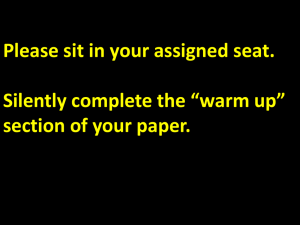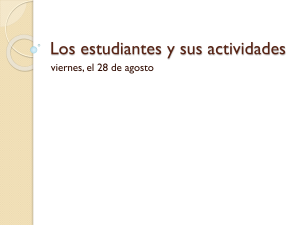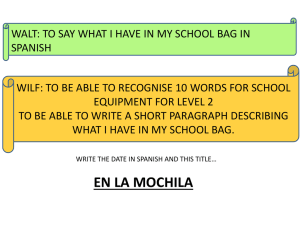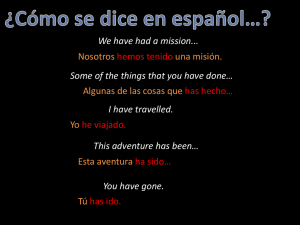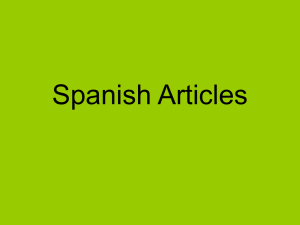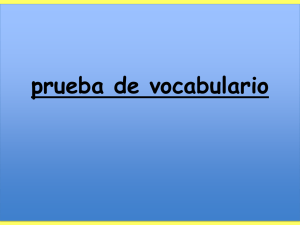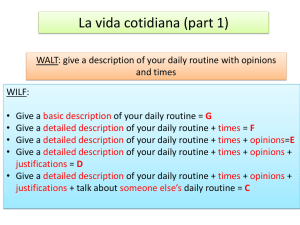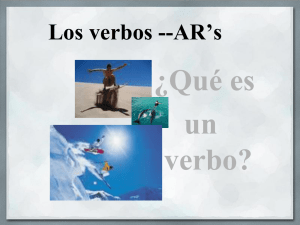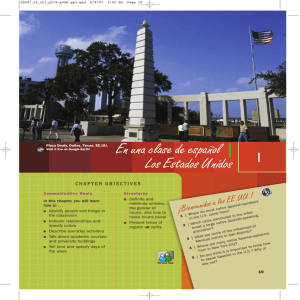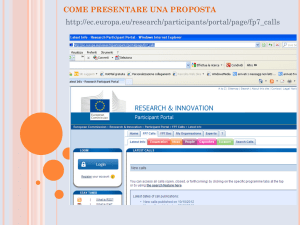Gender and Number of Nouns
advertisement
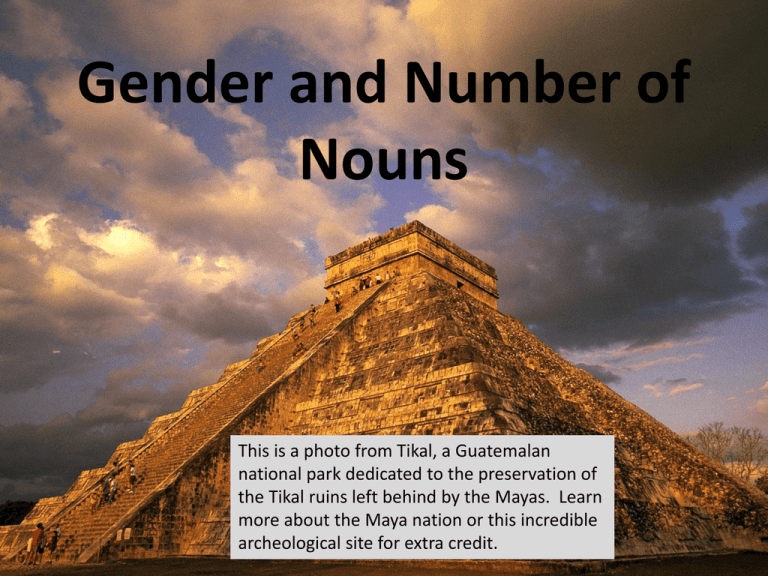
Gender and Number of Nouns This is a photo from Tikal, a Guatemalan national park dedicated to the preservation of the Tikal ruins left behind by the Mayas. Learn more about the Maya nation or this incredible archeological site for extra credit. The basics • NOUNS, their articles, and the adjectives that modify them have grammatical gender and number (Aka. Masculine/feminine & singular/plural). – (*Reminder: A noun is a person, place, thing or idea) • Animate beings – Grammatical gender is determined by biological gender. • Inanimate beings – Grammatical gender has no “rhyme or reason.” • El libro is masculine “just because.” • La silla is feminine “just because.” Articles • There are two types: definite and indefinite. • They will be masculine or feminine AND singular or plural. – They MUST match the noun they accompany in gender/#. • In English, the definite article is “the” – In Spanish, they are El, La, Los, and Las • In English, the indefinite articles are “a” and “some” – In Spanish, they are Un, Una, Unos, and Unas • The difference is…. Definite articles imply specific person(s)/place(s)/thing(s), whereas with indefinite articles, it is much less specific. – For example: • Definite – I went to the library to get THE book. – Here, you have a specific book in mind. • Indefinite – I went to the library to get A book. – Here, you do NOT have a specific book in mind. Masculino-Singular El Un The • Masculine words typically end A in -O or in a consonant. • Words that end in -E are also usually masculine, but this guide is not as dependable as the others. Masculino-singular: Ejemplos THE A ¿Por qué? El Un Libro -O El Un Pupitre -E El Un Reloj El Un Gimnasio El Un Pizarrón -consonante -O -consonante Feminino-Singular La The • Feminine words typically end in -A or in –IÓN or -AD. Una A Feminino-singular: Ejemplos THE A ¿Por qué? La Una Silla -A La Una Chica -A La Una Situación -IÓN La Una Ciudad -AD La Una Comunidad -AD Articles: Masculino-Plural Los The Unos Some Masculino-plural: Ejemplos THE SOME Los Unos Libros To pluralize: Add “S” to words that end in a vowel, and “ES” to words that end in a consonant. Los Unos Pupitres Los Unos Relojes Los Unos Gimnasios Los Unos Pizarrones* *see next page Articles: Feminino-Plural Las Unas The Some Feminino-plural: Ejemplos THE SOME * The accent is dropped from words with an accent on the final syllable when they are pluralized because the stress naturally falls on that letter now. Las Unas Sillas Las Unas Chicas Las Unas Situaciones* Las Unas Ciudades Las Unas Comunidades Excepciones • Some words go against the “rules” and therefore must be learned through practice. – Some masculine words that look feminine: • El día, el mapa, el matamoscas, el aguafiestas – Some feminine words that look masculine: • La tarde, la noche, la clase, la pared • Words ending in –E or –ISTA do not change based on gender, but their article does. – El estudiante vs. la estudiante – El dentista vs. la dentista – El artista vs. la artista Los artículos Singular Definidos There is a DEFINITE person/place/thing in mind Indefinidos There is NOT a definite person/place/thing in mind Plural THE: THE: El – masc. La – fem. Los – masc. Las – fem. A: SOME: Un – masc. Una – fem. Unos – masc. Unas – fem. Hay • Hay means “There is” or “There are” • It may be used in a question to ask “Is there?” or “Are there?” • Hay is usually used with indefinite articles rather than definite articles. • Ejemplos • • • • Hay una calculadora en mi pupitre. Hay unos libros en la mesa. Hay una profesora y unos estudiantes en la clase. ¿Hay comida en la fiesta? En una mochila hay… 1. Unos a. Estudiantes b. sillas c. libros d. escritorios 2. Unas a. Calculadoras b. sillas c. lápices d. hombres 3. Un a. Cartera (wallet) b. cajita de tic tacs c. Teléfono celular d. profesor 4. Una a. Mujer c. cuaderno b. Revista (magazine) d. Disco compacto Típicamente, ¿qué hay en un salón de clases? 1. Un a. Pupitres b. chicas c. libros d. escritorio 2. Unos a. estudiantes b. profesora c. reloj d. banderas 3. Unas a. Calculadora b. mochilas c. Libros d. profesores 4. Una a. Plumas b. Diccionarios c. cuaderno d. papelera Crédito extra • Print a copy of the SFCC campus map and label the different places on campus using the vocabulary that you have learned. • Use both the building number and the name of the place if it is something from our vocab. – Ej: Edificio 13 – el estadio
